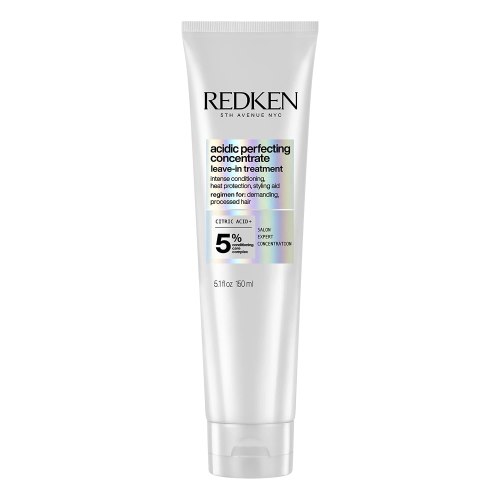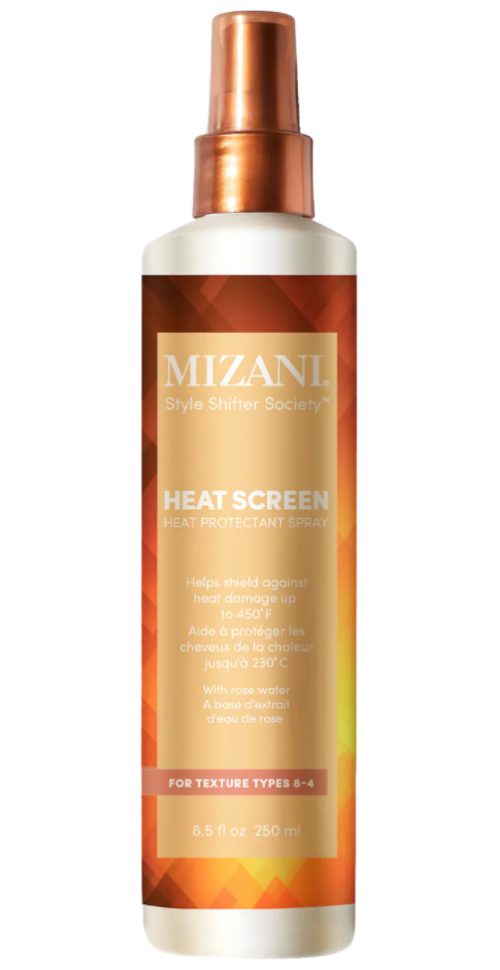Our editors independently select these products. Making a purchase through our links may earn Well+Good a commission
‘Heat Training’ Your Hair Can Cut Down on Styling Time—But Only If You Do It Safely
There's a fine line between heat-trained hair and heat-damaged hair. Here's what heat training means and how to do it the right way.

Anyone who likes to wear their kinky or curly hair straightened knows how difficult it can be to maintain this type of style. Walk outside into even the slightest bit of humidity, and the hair swells up and gets frizzy, which can be frustrating, to say the least. But if you’re regularly straightening your strands, it’s possible to literally heat train them, which means they’ll actually stay straight long after you’ve finished styling.
Experts in This Article
Al Campbell is a hairstylist and Mizani artist.
board-certified dermatologist and hair specialist at Visage Dermatology
celebrity hairstylist and artistic director for Mizani
Vernon François is a celebrity hairstylist and founder of the haircare line Vernon François
What is heat training?
To understand how this works, it’s first important to know how heat affects your hair. Your hair proteins are made up of a number of different chemical bonds, and the ones that give your hair its texture are called disulfide bonds. When these bonds are broken, it changes the texture of your hair, which is exactly what happens when you use a hot tool.
According to Sharleen St. Surin-Lord, MD, a board-certified dermatologist based in Washington DC, this is essentially the same thing that happens when you use a chemical relaxer, but to a lesser (and more temporary) extent. “A chemical relaxer is going in there, and it’s using a highly basic, a high pH product to break those disulfide bonds and change the shape of the hair from curly or coily to straight,” she explains. “Now, if you take a straightening comb or you take a flat iron, it’s doing the same thing, but it’s not as harsh. It’s trying to loosen those bonds, so you can loosen the curls, and instead of using a chemical, it’s using heat. The difference is that using a flat iron or a straightening comb is reversible. You get your hair wet and your hair goes back to its natural state.”
If you’re constantly straightening your hair with heat—aka regularly breaking those disulfide bonds—your curl pattern will loosen. This, explains Dr. St. Surin-Lord, makes it easier to straighten your hair and maintain the style. So if retaining your curl pattern in its perfect form is important to you, you’ll want to use heat sparingly. But, if you primarily heat style and don’t mind losing a bit of kink, heat training can be helpful.
The difference between ‘heat training’ and ‘heat damage’
Admittedly, heat training requires commitment. According to Dr. St. Surin-Lord, you’ll need to be applying heat to your hair every week, which can lead to damage pretty quickly. With that in mind, you’ll want to keep an eye out for any changes in the overall health of your hair.
“Healthy hair is even, has luster and shine, and doesn’t have split ends. It has elasticity and bounce, and doesn’t snap back and break when you comb it,” says Dr. St. Surin-Lord. “So if your hair is straight and flat and a little dull, you’re getting split ends, if you comb your hair and you see pieces of hair everywhere, your hair is damaged.” Additionally, damaged hair will remain straight when wet.
Because there’s such a fine line between heat training and heat damage, Al Campbell, a Mizani artist and hairstylist based in Chicago, recommends chemical straightening (think: relaxers or texturizers) instead of trying to straighten your hair with heat. “Why not relax the hair and reform the bonds to be permanently straight and healthy instead of permanently damaging them with heat?” says Campbell.
But if you aren’t ready to commit to a pro-grade treatment, Tippi Shorter, a L’Oréal Professionnel artist and Mizani global artistic director, says three key rules you need to follow in order to ensure your heat-trained hair stays healthy.
How to heat train hair
1. Start with clean and nourished hair
“You need to start with great shampoo and conditioner to start the smoothing process, and leave-in conditioner with heat protectant in it,” says Shorter, who recommends the Press Agent line from Mizani. You also want to make sure you’re doing deep conditioning treatments so that your hair is able to maintain moisture throughout the heat-styling process.
2. Use a heat protectant
“Heat protectant is necessary to help protect strands before drying or styling with heat,” Vernon François, celebrity hairstylist and founder of an eponymous hair-care line, previously told Well+Good. “All strands no matter the texture—kinky, coily, curly, wavy, or straight—can be vulnerable to heat-related stress which can lead to damage. This is especially true if your hair is already damaged, if the heat that you’re using is set to a very high level, and if you are regularly applying heat to the hair.” A heat protectant will coat the hair and help prevent damage.

Redken Acidic Perfecting Concentrate — $12.00 to $30.00
This is François’ favorite heat protectant. “Redken’s Acidic Bonding Concentrate Leave-In Treatment repairs, strengthens, smooths, color-protects all hair types, providing heat protection up to 450°F,” he says. It does this by reinforcing broken protein bonds in your hair.

Mizani Heat Screen Hair Protectant Spray — $24.00
This spray from Mizani is also a great option. It’s super lightweight, contains a UV filter, protects hair against heat up to 450°F.
3. Keep the heat low
“If tools are too hot, you run the risk of damage,” says Shorter. Aim to keep the heat at the lowest possible temperature that still allows you to get your hair smooth and straight. You’d be surprised at how low you can really go, especially if you’re using heat weekly.
4. Wrap your hair at night
“Once your hair is smoothed and styled, you want to wrap your hair at night using a nice satin cap to compress the hair and keep it smooth,” says Shorter. Not only does this prevent you from messing up your hair at night, but it also allows your hair to get used to being in that flat, straightened position.

Caplord Satin Bonnet Lined Sleeping Beanie — $16.00
5. Avoid hot tools between cleansing days
“Once your hair has been straightened, you don’t want to keep going back in every day with the heat tools because that’s an easy way to go from training to damage fast,” says Shorter. “You want to use for touching up only as needed. Realistically, you should only be putting heat on your hair right after protection, which is when hair is wet, so you’re not using heat tools until hair is cleansed, conditioned, and prepped again.”
Oh hi! You look like someone who loves free workouts, discounts for cutting-edge wellness brands, and exclusive Well+Good content. Sign up for Well+, our online community of wellness insiders, and unlock your rewards instantly.
Sign up for the Well+Good SHOP Newsletter
Get exclusive deals on wellness, beauty, fitness, and food products that have been hand-picked by our editors.
Got it, you've been added to our email list.










